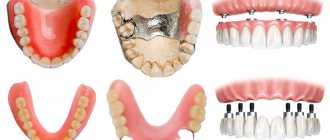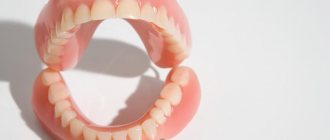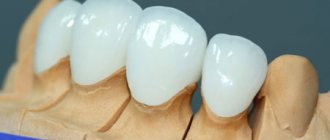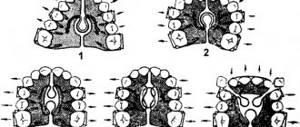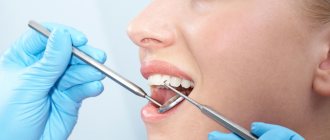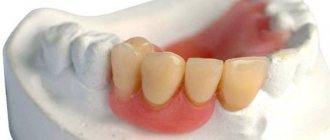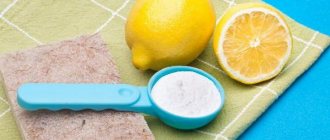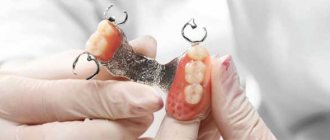Content:
- Pros and cons of splinting clasp devices
- Distinctive features of clasp splinting developments
- Indications for installation
- Contraindications
- Manufacturing
- Rules for caring for artificial teeth
The optimal solution for tooth decay and loss is implantation.
But not all dental patients can afford this option. It is inaccessible to some due to contraindications and health problems, to others due to its high cost. A good alternative to implants are splinting clasp dentures. They are metal frames on which artificial teeth and gums are placed.
The peculiarity of structures of this type is that they not only restore the integrity of the dentition, but also prevent further loosening of the movable units. They are usually used for increased tooth wear, pathological deep bite, and periodontal diseases.
Splinting stages and materials
The doctor decides which method will be used and what materials will be chosen, depending on the individual characteristics of the patient and the treatment plan. When splinting with threads, fiberglass, polyethylene, and aramid fiber are actively used. The structure of all threads is similar - it is weaving from fibers with a thickness of 3 to 5 microns. However, their chemical composition is different, and therefore their properties are different.
- Fiberglass is biologically inert and inorganic in nature. It is produced in the form of ribbons and hollow flagella. Flagella are usually used when performing manipulations on chewing teeth.
- Polyethylene is a biocompatible substance of organic origin. It is activated using plasma treatment, which allows it to better absorb the composite material, which means it is securely attached to the teeth.
- Aramid is a polyamide fiber with super strength and wear resistance. In terms of strength characteristics, aramid is not inferior to steel. It is bioinert, resistant to fungi and bacteria, and holds its shape well.
Splinting mobile teeth with fiberglass
Let's consider the technique of performing the procedure using fiberglass thread. When splinting with threads made from other materials, it is almost the same, and differs only in small nuances.
Splinting teeth with fiberglass is carried out in several stages:
- Before installing the structure, teeth are cleaned of plaque and their surface is polished. This stage is very important, since it is the accumulation of bacteria in dental plaque that causes periodontitis.
- The dental tissue is etched and a horizontal groove is created using a bur along the teeth that are to be splinted. The width and height of the recess are about 2 mm. Before this, the patient is given an injection of local anesthetic.
- A fiberglass tape is placed in the groove, and a composite material is applied on top. Under the influence of light from a halogen lamp, the composite hardens.
- The surface is polished.
In this way, a beam structure is obtained that reliably eliminates tooth mobility, has excellent aesthetics, does not affect diction and does not interfere with oral care.
Splinting with fiberglass tape is currently one of the most popular methods of performing this procedure.
Before splinting mobile teeth with fiberglass, the doctor may refer the patient for remineralization - saturation of tooth enamel with microelements. This will make it possible to prevent increased tooth sensitivity after installation of the structure. After removing the tire, the cuts must be sealed.
Cable splinting of teeth
With this method, aramid thread is used. This is a material of increased strength, which makes it possible to perform cable splinting of teeth not only for temporary, but also for long-term use.
Reference . The word aramid means "aromatic polyamide". The complex interwoven structure of the fibers gives the fabric unique strength, wear-resistant and heat-resistant properties. Aramid products are used in the production of protective clothing for the police, army, and firefighters. Kevlar is a brand under which bulletproof helmets and aramid body armor are produced.
This type of splinting is similar to fiberglass splinting in terms of the method of implementation - a horizontal cut is made on the teeth, onto which an aramid tape is applied. Then it is closed with a filling composite material. This method can also be used for dental prosthetics - the prosthesis is securely attached with an aramid thread between healthy teeth.
Splinting clasp prosthesis
Since periodontal diseases, in most cases, are accompanied by defects in the crown (the visible part of the tooth) and tooth loss, there is a need for dentures with splinting properties. The clasp design can not only fix diseased teeth, but also replace already lost ones - that is, it can essentially be a prosthetic splint.
Clasp denture is a removable structure, which consists of a frame that is held in the jaw with the help of locks or clasps. The frame is an arc (clasp) of links in the form of claw-shaped processes or clasps. The clasp is attached to healthy teeth on which crowns are placed.
Stages of manufacturing the structure:
- Measurements of the dentition are taken and the supporting units are processed.
- A cast of the patient's jaws is taken and a plaster model is created.
- The base with the frame for the crowns is cast.
- A series of fittings and corrections are made.
- The prosthesis is installed and finally adjusted.
The method has disadvantages - it is high price, the rather low aesthetics of the clasp with clasp fastenings, the need for the patient to have at least 4 supporting teeth (otherwise the structure cannot be installed).
Splinting with inlays and crowns
A tab splint is a metal arc installed on a specially prepared cutting edge. The structure is attached to crowns or pins, which are placed on the supporting teeth. The manufacture of such a design is quite difficult technically. Teeth for a crown require preparation. This type of splinting is usually performed on the front teeth.
Metal or non-metal crowns soldered together can also serve as a splint. However, they require tooth preparation – most often, this is not advisable from a medical point of view. Aesthetically made crowns made of metal-ceramics, porcelain or zirconium are expensive - and this is already unjustified from a material point of view.
Pros and cons of splinting clasp devices
In order for the prosthetic system to solve all the assigned dental problems, it is selected taking into account the condition of the remaining units, the degree of their loosening, location features, and the quality of the periodontium as a whole. If a clasp-type splinting prosthesis is selected and installed correctly, it ensures the most even distribution of the chewing load on the remaining abutment teeth.
Its other advantages include:
- compact size, making it easier for the patient to get used to the presence of a foreign body in the mouth;
- the absence of an artificial palate that spoils diction;
- sufficient strength and durability;
- creating conditions in the oral cavity that make it possible to inhibit further atrophy of bone tissue.
Among the disadvantages of clasp splinting devices:
- Lack of aesthetics. That is why young people rarely resort to their help.
- Gradual weakening of the splinting effect.
- Risk of injury to the mucous membranes of the oral cavity with metal clasps when putting on the device.
Which clasp dentures are best for teeth?
There are a large number of options for this type of prosthesis. Each of them has its own advantages and slight disadvantages. In addition, each patient who seeks prosthetics has his own individual physiological characteristics. That is why there is no clear answer to the question of which prosthesis is better to choose.
A specialist must evaluate the nature of the damage to the dentition and the possibility of its restoration. Only a doctor will be able to choose the most suitable prosthesis, which will not only look as advantageous as possible, but will also not cause any discomfort when using it.
The iOrtho clinic network provides high-quality services for correcting malocclusion with Invisalign aligners, sign up for a consultation now!
Distinctive features of clasp splinting developments
If we compare a splinting prosthesis with a conventional clasp prosthesis, it is usually more convenient to use. This is explained by the fact that its basis is smaller. It also does not cover the palate and leaves the tongue free. This means that neither diction nor a person’s taste sensations change.
It is important that splinting clasp systems do not cause atrophic changes in the gums and bone tissues of the jaw. Therefore, when wearing them for a long time, the patient does not experience any significant discomfort.
Indications for installation
Splinting clasp prosthetics is used in the following situations:
- Loss of 3-5 adjacent teeth if there is no reliable support on either side.
- Gum pathologies accompanied by frequent bleeding.
- Loss of a tooth and loosening of several of its neighbors.
- Bruxism, abnormal deep bite.
- Formation of voluminous gum pockets, exposure of tooth roots.
- Periodontal diseases.
If teeth are loose and periodontal tissue is damaged, splinting should be done as soon as possible. If this is not done, the radical units will begin to fall out. Under the influence of high chewing load, the teeth will begin to tilt in different directions and change their original position. Clasp splinting prosthetics allows you to avoid all these consequences.
Types of possible complications
With fiberglass and cable-stayed splinting, the following unpleasant consequences are possible:
- Damage to the pulp due to drilling too deep for the tire. This leads to the development of pulpitis - inflammation of the nerve, and requires depulpation of the tooth and filling of the canals.
- Allergic reactions to the material.
- Reduction in enamel thickness after professional cleaning and etching of dental tissue. In this case, sensitivity to cold and hot develops.
- If there is insufficient brushing before the procedure, bacteria may remain on the teeth. Once they begin to multiply under the tire, they lead to the development of caries and pulpitis. This requires removal of the splint and treatment of the teeth.
- Inflammatory processes of the mucous membrane near the splinting area.
Contraindications
The use of clasp splinting devices is contraindicated:
with unsatisfactory oral hygiene;- during pregnancy;
- for acute inflammatory lesions of the mucous membranes and gums;
- in the period after radiation therapy sessions;
- for oncology;
- for mental illness;
- for severe heart pathologies;
- with pronounced disturbances in the structure of bone tissue;
- with individual intolerance to metal;
- if the supporting teeth do not have the required height;
- in case of unsatisfactory condition of support units.
The doctor makes a decision on the possibility of prosthetics using a splinting clasp device after an in-person examination of the patient’s oral cavity and a series of diagnostic techniques.
Manufacturing
To install a denture, you need to visit the dentist several times. At the first stage, the doctor examines the patient and determines what dental pathologies he has. Based on the information received, he creates a clear and effective treatment plan. Takes necessary measurements, prepares supporting elements.
The second stage is making the impression tray. The client is asked to come in for impressions to be taken, which are sent to the dental laboratory. Based on them, a model is made from wax and plaster, and a base with a frame for crowns is cast.
The next stage is the first fitting of the prosthesis. During this process, detected inaccuracies are eliminated. Only after this is the wax arc replaced with a plastic analogue, and the base is ground and polished.
On the appointed day, the clasp splinting device is installed on the patient and adjusted. The installation procedure is quite simple and takes very little time. The doctor tells the client in detail how to properly remove and put on the mechanism independently, and how to care for it.
Clasp prosthetics on implants
There are cases when prosthetics are the only possible option for restoring the aesthetics of the dentition, but there are no longer any healthy teeth to attach the prosthesis in the right places. This problem can be solved by using implants. These are artificial teeth that are screwed into the jawbone. Most often these are lateral tooth sockets. After such implants take root and the doctor allows you to move on to prosthetics, the removable structure can be installed according to the standard scheme.
Rules for caring for artificial teeth
In order for the splinting clasp device to serve for a long time and maintain its aesthetic appearance, it is important to properly care for it. You can minimize the risk of frequent breakdowns if you follow simple rules:
Clean the device twice a day with a brush and paste that does not contain large abrasive particles;- rinse your mouth after each meal with warm water or an antibacterial dental rinse;
- clean the system every evening with a special solution;
- Avoid eating too hard foods and never chew on foreign hard objects;
- Visit the dentist twice a year so that he can assess the condition of the prosthesis and correct its location in the oral cavity.
If your denture fails, you should not attempt to repair it yourself. The most reasonable decision in such a situation is to contact your doctor. He will examine the breakdown and, if it can be corrected, will transfer the device to a dental technician. If it turns out that the device needs to be replaced with a new one, he will take care of this issue.
Features of care
Fastening of the clasp prosthesis (attachment).
Caring for clasp dentures involves performing the same measures as for other types of structures.
Basic rules of care include:
- for hygiene procedures (2 times a day), use a non-abrasive paste and a brush with medium-hard bristles;
- After each meal, use a mouthwash to remove small particles of food;
- clean dentures with a special solution once a day;
- undergo a preventive examination with a dentist at least once every six months in order to identify problems early;
- review your diet, reducing the consumption of sweets, soda, foods with a solid structure, the same applies to sticky and viscous foods.
Compliance with simple requirements extends the life of prosthetic structures, reduces the risk of developing dental diseases, and, importantly, minimizes the risk of prosthetic breakage.
